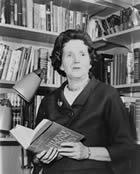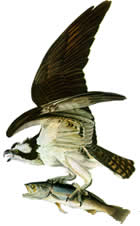Silent Spring and Rachel Carson  Rachel Carson was a biologist with the
Bureau of Fisheries and the
US Fish and Wildlife Service. She was also an author and an editor. In 1962 she published a book, Silent Spring, about the harm
pesticides
were doing to wildlife. One of the chemicals she was especially concerned about was
Dichlorodiphenyltrichloroethane
or DDT. Rachel Carson was a biologist with the
Bureau of Fisheries and the
US Fish and Wildlife Service. She was also an author and an editor. In 1962 she published a book, Silent Spring, about the harm
pesticides
were doing to wildlife. One of the chemicals she was especially concerned about was
Dichlorodiphenyltrichloroethane
or DDT.
History of DDT  DDT was first
synthesized
in 1874, but it wasn't until 1939 that
Dr. Paul Muller
discovered that DDT was extremely effective in killing insects. DDT was first used as an insecticide during World War II when it was used to kill mosquitoes. It was introduced for wide agricultural use in 1945 to help control insects like
tobacco budworms, potato beetles and other insects that damaged crops. DDT was first
synthesized
in 1874, but it wasn't until 1939 that
Dr. Paul Muller
discovered that DDT was extremely effective in killing insects. DDT was first used as an insecticide during World War II when it was used to kill mosquitoes. It was introduced for wide agricultural use in 1945 to help control insects like
tobacco budworms, potato beetles and other insects that damaged crops.
Problems Accumulate  One of the reasons DDT caused so much harm to some animals was because the chemicals in it didn't break down over time in the animals that ingested the DDT. Every time an animal ingested DDT, the DDT just continued to build up in the animal. Accumulation of DDT leads to
biomagnification. Biomagnification is when the amount of a substance found in an animal at the bottom of the food chain accumulates in higher levels in animals higher on the food chain. So a bird of preys, like the bald eagle, osprey, and peregrine falson, that ate a lot of animals that had ingested DDT, had more DDT in their system than any of the animals it ate because its body stored the DDT from all of the animals that it ate. One of the reasons DDT caused so much harm to some animals was because the chemicals in it didn't break down over time in the animals that ingested the DDT. Every time an animal ingested DDT, the DDT just continued to build up in the animal. Accumulation of DDT leads to
biomagnification. Biomagnification is when the amount of a substance found in an animal at the bottom of the food chain accumulates in higher levels in animals higher on the food chain. So a bird of preys, like the bald eagle, osprey, and peregrine falson, that ate a lot of animals that had ingested DDT, had more DDT in their system than any of the animals it ate because its body stored the DDT from all of the animals that it ate.
|
|
|
|
Thinning Shells  DDT made it more difficult for birds to absorb calcium and the lack of calcium made their egg shells thinner and many eggs broke before they could hatch. Because birds like eagles and osprey typically only lay 1-3 eggs at a time, losing one or two eggs due to shell thinning could have a dramatic impact on their populations. DDT made it more difficult for birds to absorb calcium and the lack of calcium made their egg shells thinner and many eggs broke before they could hatch. Because birds like eagles and osprey typically only lay 1-3 eggs at a time, losing one or two eggs due to shell thinning could have a dramatic impact on their populations.
A Movement is Born
In her book Rachel Carson asked that research be conducted to ensure that pesticides were used safely. Congressional hearings were held, studies were ordered, and DDT was banned in 1972 by the Environmental Protection Agency after studies found that the chemical led to the thinning of eggs in some birds. Many people think that the publishing of Silent Spring marks to beginning of the modern environmentalist movement.
Populations Increase  Since the ban on DDT, the population of bald eagles has improved.
In 1963 there were
417 nesting pairs of bald eagles in the continental United States.
Today there are more than 8,000 nesting pairs. In
1981 there were 8,000 breeding pairs of ospreys, by
1994 that number had risen to 14, 246 pairs. Since the ban on DDT, the population of bald eagles has improved.
In 1963 there were
417 nesting pairs of bald eagles in the continental United States.
Today there are more than 8,000 nesting pairs. In
1981 there were 8,000 breeding pairs of ospreys, by
1994 that number had risen to 14, 246 pairs.
|

 Rachel Carson was a biologist with the
Bureau of Fisheries and the
US Fish and Wildlife Service. She was also an author and an editor. In 1962 she published a book, Silent Spring, about the harm
pesticides
were doing to wildlife. One of the chemicals she was especially concerned about was
Dichlorodiphenyltrichloroethane
or DDT.
Rachel Carson was a biologist with the
Bureau of Fisheries and the
US Fish and Wildlife Service. She was also an author and an editor. In 1962 she published a book, Silent Spring, about the harm
pesticides
were doing to wildlife. One of the chemicals she was especially concerned about was
Dichlorodiphenyltrichloroethane
or DDT.  DDT was first
synthesized
in 1874, but it wasn't until 1939 that
Dr. Paul Muller
discovered that DDT was extremely effective in killing insects. DDT was first used as an insecticide during World War II when it was used to kill mosquitoes. It was introduced for wide agricultural use in 1945 to help control
DDT was first
synthesized
in 1874, but it wasn't until 1939 that
Dr. Paul Muller
discovered that DDT was extremely effective in killing insects. DDT was first used as an insecticide during World War II when it was used to kill mosquitoes. It was introduced for wide agricultural use in 1945 to help control  One of the reasons DDT caused so much harm to some animals was because the chemicals in it didn't break down over time in the animals that ingested the DDT. Every time an animal ingested DDT, the DDT just continued to build up in the animal. Accumulation of DDT leads to
biomagnification. Biomagnification is when the amount of a substance found in an animal at the bottom of the food chain accumulates in higher levels in animals higher on the food chain. So a bird of preys, like the
One of the reasons DDT caused so much harm to some animals was because the chemicals in it didn't break down over time in the animals that ingested the DDT. Every time an animal ingested DDT, the DDT just continued to build up in the animal. Accumulation of DDT leads to
biomagnification. Biomagnification is when the amount of a substance found in an animal at the bottom of the food chain accumulates in higher levels in animals higher on the food chain. So a bird of preys, like the  DDT made it more difficult for birds to absorb calcium and the lack of calcium made their egg shells thinner and many eggs broke before they could hatch. Because birds like eagles and osprey typically only lay 1-3 eggs at a time, losing one or two eggs due to shell thinning could have a dramatic impact on their
DDT made it more difficult for birds to absorb calcium and the lack of calcium made their egg shells thinner and many eggs broke before they could hatch. Because birds like eagles and osprey typically only lay 1-3 eggs at a time, losing one or two eggs due to shell thinning could have a dramatic impact on their  Since the ban on DDT, the population of bald eagles has improved.
In 1963 there were
417 nesting pairs of bald eagles in the continental United States.
Today there are more than 8,000 nesting pairs. In
1981 there were 8,000 breeding pairs of ospreys, by
1994 that number had risen to 14, 246 pairs.
Since the ban on DDT, the population of bald eagles has improved.
In 1963 there were
417 nesting pairs of bald eagles in the continental United States.
Today there are more than 8,000 nesting pairs. In
1981 there were 8,000 breeding pairs of ospreys, by
1994 that number had risen to 14, 246 pairs.